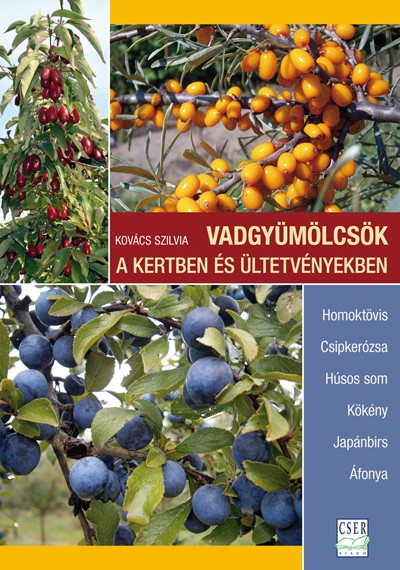Wild fruits in the garden and in plantations.Sea buckthorn - Rose hip - Fleshy som - Pumpkin - Japanese quince
Nowadays, consumers and growers have also become more interested in wild fruit. They are gaining ground in everyday use thanks to their unusual flavour and, in many cases, their medicinal properties.
More and more farms are planting and growing wild fruit species. Our book provides a thorough grounding in this work and also gives retailers all t...
Long description
Shipping
block
A termék most nem kapható. Később még valószínűleg elérhető lesz.
Nowadays, consumers and growers have also become more interested in wild fruit. They are gaining ground in everyday use thanks to their unusual flavour and, in many cases, their medicinal properties.
More and more farms are planting and growing wild fruit species. Our book provides a thorough grounding in this work and also gives retailers all the help they need to encourage the planting of a few useful and beautiful specimens.
From the contents
Choosing a wild fruit species for the garden
Sea buckthorn (Hippophaë rhamnoides)
Origin and distribution. History of its cultivation
Characterisation of the plant
Characteristics of its cultivation
Varieties
Time and method of harvesting the fruit
Use of sea buckthorn
The rose hip (Rosa sp.)
Origin, distribution. History of cultivation
Characterisation of the species cultivated
Characteristics of its cultivation
Propagation
Varieties
Time of harvesting the fruit
Use
The fleshy som (Cornus mas)
Origin, distribution. History of its cultivation
Characterisation of the plant
Characteristics of its cultivation
Propagation
Varieties
Time and method of harvesting the fruit
Use
The pear (Prunus spinosa)
Origin, distribution. History of its cultivation
Description of the plant
Characteristics of its cultivation
Propagation
Varieties
Time and method of harvesting the fruit
Use
Japanese quince or ornamental quince (Chaenomeles sp.)
Origin, distribution. History of cultivation
Characterisation of the species cultivated
Specific features of its cultivation
Varieties
Time and method of harvesting the fruit
Its use
The blueberry (Vaccinium sp.)
Origin, distribution. Economic importance
Land requirements
Propagation
Species and varieties collected and cultivated
Cranberries (Vaccinium oxycoccos)
Blueberries (Vaccinium myrtillus)
Cranberries (Vaccinium vitis-idaea)
Cultivated blueberries (Vaccinium macrocarpon)
Lowbush blueberries (Vaccinium angustifolium)
Lowbush blueberry (Vaccinium corymbosum)
Blueberry species of value to growers, processors and breeders
Annex
Main nutritional values of fruits of wild fruit species
More and more farms are planting and growing wild fruit species. Our book provides a thorough grounding in this work and also gives retailers all the help they need to encourage the planting of a few useful and beautiful specimens.
From the contents
Choosing a wild fruit species for the garden
Sea buckthorn (Hippophaë rhamnoides)
Origin and distribution. History of its cultivation
Characterisation of the plant
Characteristics of its cultivation
Varieties
Time and method of harvesting the fruit
Use of sea buckthorn
The rose hip (Rosa sp.)
Origin, distribution. History of cultivation
Characterisation of the species cultivated
Characteristics of its cultivation
Propagation
Varieties
Time of harvesting the fruit
Use
The fleshy som (Cornus mas)
Origin, distribution. History of its cultivation
Characterisation of the plant
Characteristics of its cultivation
Propagation
Varieties
Time and method of harvesting the fruit
Use
The pear (Prunus spinosa)
Origin, distribution. History of its cultivation
Description of the plant
Characteristics of its cultivation
Propagation
Varieties
Time and method of harvesting the fruit
Use
Japanese quince or ornamental quince (Chaenomeles sp.)
Origin, distribution. History of cultivation
Characterisation of the species cultivated
Specific features of its cultivation
Varieties
Time and method of harvesting the fruit
Its use
The blueberry (Vaccinium sp.)
Origin, distribution. Economic importance
Land requirements
Propagation
Species and varieties collected and cultivated
Cranberries (Vaccinium oxycoccos)
Blueberries (Vaccinium myrtillus)
Cranberries (Vaccinium vitis-idaea)
Cultivated blueberries (Vaccinium macrocarpon)
Lowbush blueberries (Vaccinium angustifolium)
Lowbush blueberry (Vaccinium corymbosum)
Blueberry species of value to growers, processors and breeders
Annex
Main nutritional values of fruits of wild fruit species
| Weight: | 0.2 kg |
|---|---|
| Width: | 240 mm |
| Height: | 15 mm |
| Length: | 170 mm |
| Aviability: | 1-4 nap |
| Basic sales unit: | db |
Login
Login or registration with a social account
Login
Login or registration with a social account
